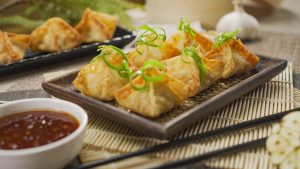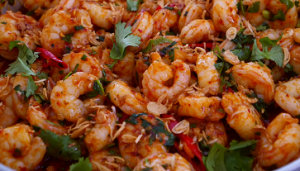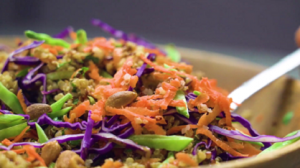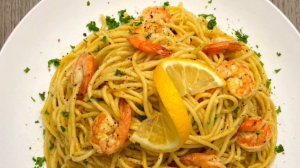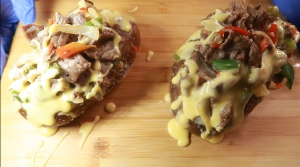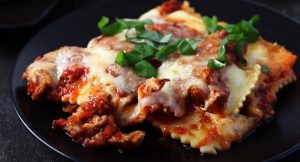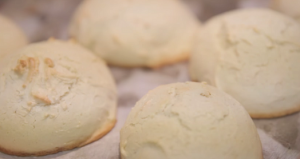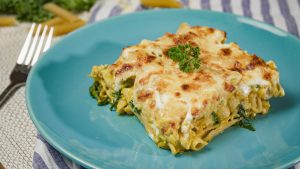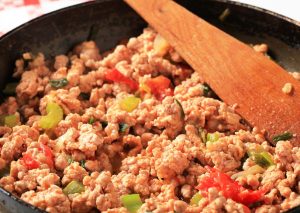Welcome to the vibrant world of Thai cuisine. This Thai peanut shrimp recipe is a delightful mix of savory, sweet, and tangy flavors. Simple to prepare, it combines succulent shrimp, creamy peanut sauce, and the exotic touch of coconut milk. It's the perfect dish for a cozy night in or to impress guests at your next dinner party.

The ingredients for this recipe are fairly straightforward and available at most grocery stores. However, there are a few that might need a special trip to an Asian supermarket or a well-stocked grocery store. These include coconut milk, which adds a rich, creamy texture and a subtle sweetness to the dish, and creamy peanut butter, which forms the base of the satay-like sauce. You'll also need rice wine vinegar, a common ingredient in Asian cuisine that adds a tangy kick.
Ingredients for Thai Peanut Shrimp
Vegetable oil: Used for frying the shrimp. Its mild flavor does not overpower the other ingredients.
Shrimp: The star of the dish. Fresh shrimp is always the best option but frozen works just fine too.
Coconut milk: Adds a creamy, tropical twist to the dish.
Peanut butter: Used to create the rich, savory sauce.
Soy sauce: Adds a salty, umami flavor to the dish.
Honey: Balances the saltiness with a hint of sweetness.
Rice wine vinegar: Provides a tangy contrast to the richness of the other ingredients.
Lime juice: Adds a bright, citrusy note to the dish.
Sesame oil: Its nutty flavor complements the peanut butter nicely.
Garlic: A staple in Thai cooking, it adds a robust, aromatic flavor.
Ginger: Another key ingredient in Thai cuisine, it provides a warming, spicy kick.
Cilantro: Used as a garnish. Its fresh, citrusy flavor balances the rich sauce.
One reader, Arney Boss says:





This Thai peanut shrimp recipe is a game-changer! The creamy peanut sauce is a flavor explosion, and the shrimp is perfectly cooked. The combination of coconut milk, soy sauce, and honey creates a delightful balance of sweet and savory. It's a must-try for anyone who loves Thai cuisine!
Key Techniques for Making Thai Peanut Shrimp Recipe
How to cook the shrimp: The shrimp should be cooked on medium-high heat for 1 to 2 minutes on each side until they turn pink and opaque.
How to make the peanut sauce: Combine the coconut milk, peanut butter, soy sauce, honey, rice wine vinegar, lime juice, sesame oil, garlic, and ginger in the pan and let it reduce for 5 minutes, stirring occasionally until the sauce thickens slightly.
How to coat the shrimp: Once the sauce has reduced, add the cooked shrimp back to the pan and toss them in the peanut sauce until they are evenly coated.
How to garnish with cilantro: Sprinkle the finished dish with fresh cilantro leaves before serving to add a pop of color and flavor.
How To Make Thai Peanut Shrimp
Whip up a 20-minute dinner with this Thai peanut shrimp cooked in coconut milk and peanut butter sauce packed with the flavors of garlic and ginger.
Serves:
Ingredients
- 2tbspvegetable oil
- 2lbshrimp,(13-15 count) peeled and deveined
- 7ozcoconut milk,(½ can)
- ⅓cupcreamy peanut butter
- 2tbsplow sodium soy sauce
- 2tbsphoney
- 1tbsprice wine vinegar
- 1tbsplime juice
- ½tspsesame oil
- 3clovesgarlic,minced
- 1tbspginger,minced
- cilantro,for garnish
Instructions
-
Add the oil to a large skillet on medium-high heat.
-
Add the shrimp to the pan, cooking on each side for 1 to 2 minutes.
-
Remove the shrimp from the pan and set aside.
-
Add the coconut milk, peanut butter, soy sauce, honey, rice wine vinegar, lime juice, sesame oil, garlic, and ginger to the pan and let reduce for 5 minutes.
-
Add the shrimp back to the pan to coat.
Nutrition
- Calories: 331.40kcal
- Fat: 21.03g
- Saturated Fat: 8.49g
- Trans Fat: 0.07g
- Monounsaturated Fat: 7.81g
- Polyunsaturated Fat: 3.29g
- Carbohydrates: 12.51g
- Fiber: 0.89g
- Sugar: 7.37g
- Protein: 25.05g
- Cholesterol: 190.51mg
- Sodium: 1034.61mg
- Calcium: 101.34mg
- Potassium: 368.73mg
- Iron: 1.83mg
- Vitamin A: 89.21µg
- Vitamin C: 2.26mg
Helpful Technique Tip for Thai Peanut Shrimp Recipe
When cooking the shrimp, be sure not to overcook them as they can quickly become tough and rubbery. Shrimp cook very quickly and you'll know they're done when they turn pink and opaque. If you're unsure, cut into one - it should be white and opaque all the way through. Also, when adding the shrimp back into the pan to coat with the sauce, ensure that all the shrimp are evenly coated for a balanced flavor in every bite.
Time-Saving Tips for Preparing Thai Peanut Shrimp
Prep ahead: Chop vegetables, measure out ingredients, and devein shrimp in advance to streamline the cooking process.
One-pot wonder: Opt for a single skillet or pot to minimize cleanup and simplify the cooking process.
Organized workspace: Keep your cooking area clean and organized to avoid wasting time searching for utensils and ingredients.
Efficient multitasking: While the sauce is reducing, prep the shrimp to make the most of your time in the kitchen.
Quick marination: Marinate the shrimp while preparing other ingredients to infuse flavor without adding extra time.
Substitute Ingredients For Thai Peanut Shrimp Recipe
vegetable oil - Substitute with coconut oil: Coconut oil can add a hint of tropical flavor to the dish and complement the coconut milk in the recipe.
shrimp - Substitute with chicken breast: Chicken breast can be used as a substitute for shrimp to create a different protein option for the dish.
coconut milk - Substitute with cashew cream: Cashew cream can provide a creamy texture and nutty flavor similar to coconut milk.
creamy peanut butter - Substitute with almond butter: Almond butter can be used as a substitute for peanut butter to add a different nutty flavor to the dish.
low sodium soy sauce - Substitute with tamari: Tamari is a gluten-free alternative to soy sauce and can provide a similar umami flavor to the dish.
honey - Substitute with maple syrup: Maple syrup can add a natural sweetness and depth of flavor to the dish.
rice wine vinegar - Substitute with apple cider vinegar: Apple cider vinegar can provide a slightly fruity and tangy flavor similar to rice wine vinegar.
lime juice - Substitute with lemon juice: Lemon juice can provide a similar citrusy acidity to the dish.
sesame oil - Substitute with peanut oil: Peanut oil can add a nutty flavor and aroma similar to sesame oil.
garlic - Substitute with shallots: Shallots can provide a milder, sweeter flavor compared to garlic.
ginger - Substitute with lemongrass: Lemongrass can add a citrusy, herbal flavor similar to ginger.
cilantro - Substitute with Thai basil: Thai basil can provide a similar fresh and aromatic flavor to the dish.
Presentation Ideas for Thai Peanut Shrimp
Elevate the plating: Arrange the shrimp in a circular pattern on a large, white, oval-shaped plate. Place a small bowl of the Thai peanut sauce in the center of the plate. Garnish with a sprinkle of chopped cilantro around the shrimp for a pop of color and freshness.
Incorporate height: Consider using a small pedestal or riser to elevate the plate, creating a visually appealing presentation. This will add dimension and sophistication to the dish.
Emphasize symmetry: Place the shrimp in a symmetrical arrangement on the plate, ensuring that each element is thoughtfully positioned. This attention to detail will showcase precision and artistry.
Utilize negative space: Allow the white space on the plate to complement the vibrant colors of the dish. This will draw attention to the beautifully plated shrimp and accentuate the overall presentation.
Highlight the sauce: Use a small spoon to drizzle a thin line of the Thai peanut sauce around the edge of the plate, creating an artistic and flavorful border for the dish.
Add a touch of elegance: Consider incorporating edible flowers or microgreens as a delicate and refined garnish, adding a touch of elegance to the presentation.
Essential Kitchen Tools for Making Thai Peanut Shrimp
- Chef's knife: A versatile tool used for chopping, slicing, and dicing ingredients with precision.
- Cutting board: Provides a stable surface for cutting and preparing ingredients.
- Skillet: Ideal for sautéing and cooking the shrimp to perfection.
- Whisk: Used for blending and emulsifying the sauce ingredients together.
- Measuring cups and spoons: Essential for accurately measuring out the ingredients for the recipe.
- Garlic press: Useful for quickly and efficiently mincing garlic for the sauce.
- Grater: Perfect for grating fresh ginger to infuse the dish with flavor.
- Spatula: Helps in flipping and stirring the shrimp while cooking.
- Large mixing bowl: Used for tossing the shrimp in the sauce and ensuring they are evenly coated.
- Skewers: Optional for threading the shrimp onto skewers for grilling instead of pan-searing.
Storage and Freezing Instructions for Thai Peanut Shrimp
- To store leftover thai peanut shrimp, allow it to cool completely to room temperature before transferring it to an airtight container. Refrigerate for up to 3-4 days.
- When reheating, ensure that the shrimp is heated through to an internal temperature of 165°F (74°C) to maintain food safety.
- For longer storage, you can freeze the thai peanut shrimp. Place the cooled dish in a freezer-safe container or resealable bag, removing as much air as possible to prevent freezer burn.
- Label the container with the date and contents for easy identification.
- Frozen thai peanut shrimp can be stored for up to 2-3 months.
- To reheat from frozen, thaw the shrimp in the refrigerator overnight. Once thawed, reheat in a skillet over medium heat until the sauce is bubbling and the shrimp is heated through.
- Note: The texture of the shrimp may change slightly after freezing and thawing, but the flavor should remain delicious.
How To Reheat Thai Peanut Shrimp Leftovers
To reheat leftover thai peanut shrimp, start by preheating your oven to 350°F (175°C). Place the shrimp in an oven-safe dish and cover it with aluminum foil. Bake for about 10-15 minutes, or until the shrimp is heated through. This method helps to retain the moisture and prevent the shrimp from drying out.
Another option is to reheat the shrimp in a skillet on the stovetop. Add a small amount of vegetable oil or coconut milk to the pan and heat it over medium heat. Add the shrimp and stir occasionally until they are warmed through. This method is quick and easy, and the added liquid helps to keep the shrimp moist.
If you have a microwave, you can also use it to reheat the shrimp. Place the shrimp in a microwave-safe dish and cover it with a damp paper towel. Microwave on high for 1-2 minutes, or until the shrimp is heated through. Be careful not to overcook the shrimp, as they can become tough and rubbery.
For a tasty twist, try reheating the shrimp in a curry sauce or coconut broth. Simply add the shrimp to the sauce or broth and heat it over medium heat until the shrimp is warmed through. This method adds extra flavor to the dish and helps to keep the shrimp moist.
If you have leftover rice or noodles, you can also reheat them along with the shrimp. Place the rice or noodles in a pan with a small amount of liquid (such as water, broth, or coconut milk) and heat them over medium heat. Add the shrimp to the pan and stir until everything is heated through. This method creates a complete meal and helps to revive any leftover starches.
Interesting Fact About Thai Peanut Shrimp
Thai Peanut Shrimp Recipe is a popular dish in Thailand, known for its fusion of flavors. The combination of creamy peanut butter, coconut milk, and soy sauce creates a rich and savory sauce that perfectly complements the tender shrimp. This dish is a great source of protein and healthy fats, making it a delicious and nutritious option for a balanced meal. It's also a versatile recipe that can be easily customized with additional vegetables or spices to suit individual preferences.
Is Making Thai Peanut Shrimp at Home Cost-Effective?
This Thai peanut shrimp recipe is quite cost-effective for a household. The ingredients, such as shrimp, coconut milk, and peanut butter, are relatively affordable and can be found in most grocery stores. The dish offers a delightful combination of flavors and textures, making it a satisfying and enjoyable meal for the entire family. The approximate cost for a household of 4 people is around $20-$25, making it a budget-friendly option for a delicious and nutritious dinner. I would rate this recipe a solid 8 out of 10 for its affordability, taste, and overall appeal.
Is Thai Peanut Shrimp Healthy or Unhealthy?
The Thai peanut shrimp recipe is a delicious and flavorful dish, but it may not be the healthiest option due to a few key ingredients. Here's a breakdown of the recipe's nutritional aspects:
- Shrimp is a lean protein source, low in calories and rich in nutrients like selenium, vitamin B12, and omega-3 fatty acids.
- Coconut milk and peanut butter, while adding creamy texture and flavor, are high in saturated fat and calories.
- Soy sauce contains sodium, which can contribute to high blood pressure if consumed in excess.
- Honey and rice wine vinegar add sweetness and acidity, but honey also adds extra calories and sugars.
- Garlic and ginger offer potential health benefits, such as anti-inflammatory and antioxidant properties.
To make this recipe healthier, consider the following suggestions:
- Use light coconut milk instead of regular to reduce the saturated fat and calorie content.
- Opt for natural, unsweetened peanut butter to minimize added sugars and oils.
- Replace soy sauce with low-sodium alternatives like coconut aminos or reduced-sodium soy sauce.
- Reduce the amount of honey used, or substitute with a natural, low-calorie sweetener like stevia or monk fruit.
- Increase the amount of garlic and ginger to boost the dish's nutritional value and flavor profile.
- Serve the shrimp with a side of steamed vegetables or a fresh salad to add fiber, vitamins, and minerals to the meal.
- Use whole grain rice or quinoa instead of white rice to increase the fiber content and provide a more balanced carbohydrate source.
Editor's Opinion on This Thai Peanut Shrimp Recipe
The Thai peanut shrimp recipe is a delightful fusion of flavors. The combination of creamy coconut milk, rich peanut butter, and tangy lime juice creates a luscious sauce that perfectly complements the succulent shrimp. The hint of ginger and garlic adds depth to the dish, while the touch of honey provides a subtle sweetness. The recipe's balance of savory and sweet, along with the aromatic cilantro garnish, makes it a truly satisfying and memorable culinary experience.
Enhance Your Thai Peanut Shrimp Recipe with These Unique Side Dishes:
Similar Recipes to Thai Peanut Shrimp
Appetizer and Dessert Pairings for Thai Peanut Shrimp
Why trust this Thai Peanut Shrimp Recipe:
This #food# recipe is a #trustworthy# choice because it features #fresh# and #flavorful# ingredients such as succulent #shrimp#, creamy #coconut milk#, rich #peanut butter#, and zesty #lime juice#. The combination of #sesame oil#, #garlic#, and #ginger# adds depth and complexity to the dish, while the #honey# and #rice wine vinegar# provide a perfect balance of #sweetness# and #tanginess#. The recipe has been meticulously crafted to ensure a harmonious blend of #Thai# flavors, making it a #reliable# and #delicious# option for anyone seeking an authentic #culinary# experience.
Was this page helpful?
Have your own special recipe to share? Submit Your Recipe Today!



